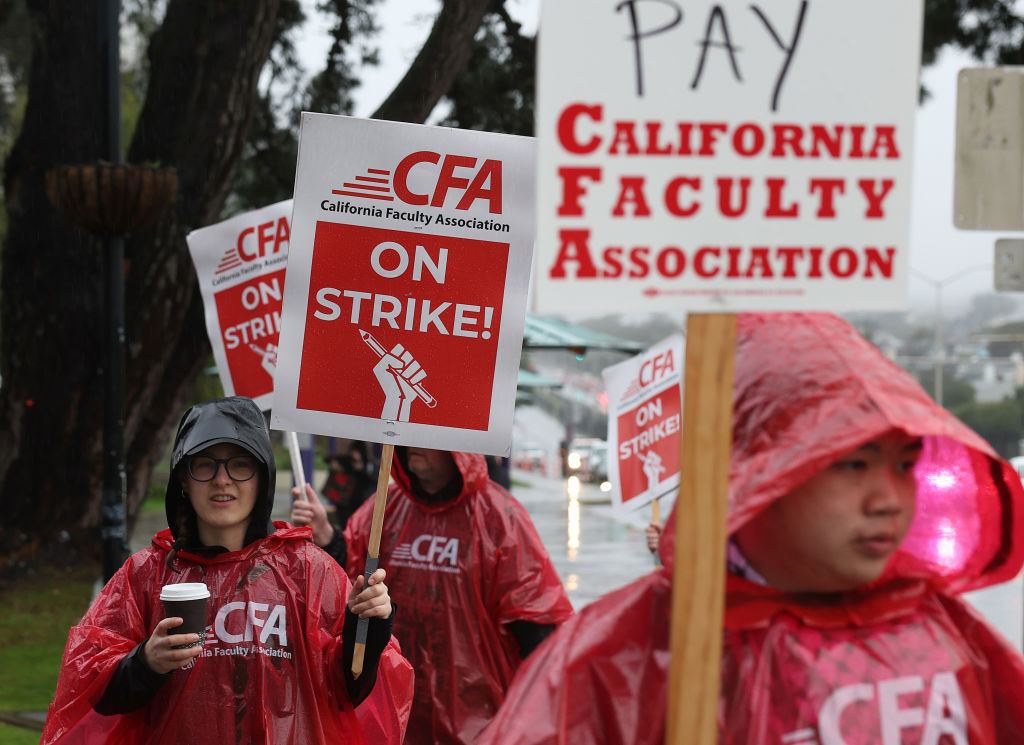
After a 2023 marked by conspicuous union victories in California and around the county, 2024 has begun in similar fashion.
One day into a scheduled five-day strike, the 29,000-member California Faculty Association announced late Monday a tentative agreement with the California State University system on a deal that achieves a substantial chunk of what union negotiators pushed for.
Professors, lecturers, coaches, counselors and other CFA members were instructed to report to work as usual at all 23 CSU campuses Tuesday. They do so after securing a 5% raise retroactive to July 2023 and another 5% hike commencing in July 2024, contingent on the state not reducing its base funding to the CSU system.
In addition, the salary floor for the lowest paid faculty members in the system was raised $3,000 retroactive to last year, with another $3,000 bump due this summer. The union also secured an increase in paid parental leave from six weeks to 10, as well as improvements in access to gender inclusive restrooms and safe lactation spaces.
The negotiation, which was a union-requested reopener of an existing contract, extends the current pact for a year to June 30, 2025, meaning the two sides will be gearing up for another negotiation in a matter of months. Serious issues remain in a 460,000-student CSU system that has increasingly relied upon part-time, lower-paid professors to keep costs down, even as university trustees approved a 30% tuition hike over the next five years.
But here and now, the agreement, with its combined 10% pay raise by July, takes steps toward addressing the financial concerns that drove the union toward a strike in the first place. Before Monday night, the CFA had stood firm on its demand for a 12% raise, and it sought a $10,000 increase in the salary floor of the lowest paid faculty.
“We’ve been seeing people leaving for other teaching positions, even leaving for community college positions, because their CSU pay wasn’t keeping up with the increased workloads they’re asked to carry,” said Anthony Ratcliff, a Pan-African Studies professor at CSU Los Angeles. “This was definitely a long time coming.”
As recently as last Friday, CSU leadership wasn’t indicating much wiggle room, with Vice Chancellor for Human Resources Leora Freedman telling reporters in a video conference that the union’s ask would trigger $380 million in new recurring spending, which she said the system could not afford. CSU negotiators had already walked away from the table and imposed a unilateral, one-time 5% raise for faculty effective Jan. 31. That’s no longer the case.
In the bigger picture, the system could not afford to bleed talent, especially given that adjunct or part-time professors make up 40% or more of the faculty at many CSU campuses. Most of them are on one-year contracts, with no assurance of renewal.
“I am extremely pleased and deeply appreciative that we have reached common ground with CFA that will end the strike immediately,” CSU Chancellor Mildred García said in a statement Monday night. “The agreement enables the CSU to fairly compensate its valued, world-class faculty while protecting the university system’s long-term financial sustainability.”
The unexpected breakthrough came a few days after CSU officials reached a tentative agreement on a three-year contract with the Teamsters Local 2010 Union, representing 1,100 skilled trade employees. That deal, which includes a 5% raise retroactive to last July, prompted the union to call off its own strike, which was scheduled to coincide with Monday’s first day of the CFA action.
To CFA members, the agreement simply begins to close a gap on wages that has been widening for years. Antonio Gallo, an adjunct faculty lecturer at CSU Northridge and a CFA officer, said the average CSUN lecturer earns about $54,000 while teaching a full load of classes, often five per semester. Class sizes, too, have swelled from 28 or 30 several years ago to 40 or more now, he said.
“They said they couldn’t afford more than a 5% raise, but they’re sitting on billions of dollars in reserves,” Gallo said of CSU. “Meanwhile, we’ve got people teaching a full load here and then picking up another bunch of classes somewhere else just to pay the basic cost of living in this area.”
Another CSUN professor, who asked not to be identified, said her original adjunct contract called for her to teach four classes in the fall and two in the spring. “But I’ve been doing five and five for the last few years, because of how huge the need has been,” she said. “That’s what a full-time professor would teach, but I made $3,700 last month after taxes — and I’m on the higher end of the scale. That is a very messed-up system.”
The CFA strike was forecast in part by a series of one-day walkouts in December at four campuses: CSU Los Angeles, Cal Poly Pomona, San Francisco State and Sacramento State. But Monday’s action was still stunning in its scope. It was the largest strike by university faculty in U.S. history.
The sudden settlement appears to mark another victory for union members working in large-scale coordination in California. Both the writers’ and actors’ unions in Hollywood struck the major production studios last summer, with each ultimately winning substantial wage gains and job-related protections. Workers at some 60 Los Angeles area hotels, meanwhile, have picketed in support of each other since last summer and so far have won tentative agreements with at least two dozen of the businesses.
Negotiators for the CFA know they’re not done. In the next deal, they’ll be pushing for another wage hike as well as a cap on class sizes. But a 10% raise over a period of about a year makes for a good start.
“This is what People Power looks like,” Gallo said in a CFA news release. “This deal immensely improves working conditions for faculty, and strengthens learning conditions for students.”







